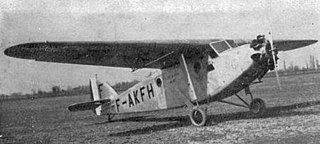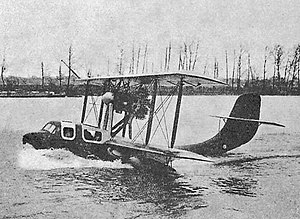
The Loire 70 was a 1930s French long-range maritime reconnaissance flying boat produced by Loire Aviation.

The FBA 21 and 23 were small flying boat airliners built in France in the mid-1920s. Their development was an attempt by FBA to develop a commercial version of their FBA 19 bomber which had failed to attract orders from military buyers. Retaining the same basic design as their predecessor, the Model 21 added an enclosed cabin for four passengers. Unfortunately for FBA, they aroused as little interest as their military counterparts, and only a handful were built in a number of slight variations, including one example of a dedicated mail plane.
The Nord 1400 Noroit was a French reconnaissance and air-sea rescue flying boat designed and built by Nord Aviation for the French Navy.

The Wibault 280-T was a French 12-passenger civil airliner produced by Wibault backed by money from the Penhoët shipyards and also known as 'Penhoët Wibault'.

The Potez 29 was a 1920s French passenger biplane designed and built by Avions Henry Potez. Although designed as a civilian aircraft, a large number entered service with the French Air Force.

The Potez 32 and its military version the Potez 33 was a single-engine French monoplane transport built by Potez and based on the Potez 29 biplane.

The Morane-Saulnier Vanneau is a two-seat basic trainer built in France by Morane-Saulnier and ordered by the French Air Force.

The SPCA 80 was a French transport monoplane designed by Société Provençale de Constructions Aéronautiques (SPCA) to meet a French government requirement for a single-engined colonial transport, specifically for police duties. It was a single-engined high-wing cantilever monoplane with a fixed tailskid landing gear. It had a cockpit for a crew of two and a cabin for four passengers. It was powered by a nose-mounted Gnome-Rhône 7Kb radial engine. Only a single example was built, registration F-AKFH.
The Farman F.150 was a 1920s French twin-engined biplane designed by Farman as a day bomber.
The Latécoère 582 was a 1930s French long-range patrol flying-boat designed and built by Latécoère for the French Navy. First flown on 25 July 1935 the 583 was a parasol-wing monoplane flying-boat. Powered by three 890 hp (663 kW) Gnome-Rhône 14Kirs radial piston engines. The French Navy choose to buy the Breguet Bizerte and the one Latécoère 582 ended up as a flying test bed at Saint-Raphaël.

The Farman F.211 was a French four-seat day or night bomber designed and built by the Farman Aviation Works for the French Air Force.
The Farman F.270 was a prototype French bomber/torpedo-bomber designed and built by the Farman Aviation Works for the French Air Force.

The ANF Les Mureaux 120 was a 1930s French three-seat military night reconnaissance monoplane built by ANF Les Mureaux.

The Bernard 70 was a 1920s design for a French single-seat monoplane fighter aircraft by the Société des Avions Bernard. It was not built but was developed into a racing monoplane designated the Bernard S-72,. It was further developed into single-seat fighters, the Bernard 74-01 and Bernard 74-02, although only two of the fighters were built.
The Lorraine 9N Algol was a French 9-cylinder radial aeroengine built and used in the 1930s. It was rated at up to 370 kW (500 hp), but more usually in the 220–300 kW (300–400 hp) range.

The Besson MB.36 was a French monoplane flying-boat designed by Marcel Besson, only one was built.
The SNCASE SE-400 was a prototype French twin-engined coastal patrol floatplane of the Second World War. A single example was flown, but development was abandoned in May 1940 owing to the German invasion of France.

The Blériot 111 was a French four-seat executive transport monoplane designed by André Herbemont. The first French aircraft to be fitted with a retractable landing gear, after six years development it was not ordered into production.

The SAB-SEMA 10 was a single-engine advanced trainer, designed and built in France as the SEMA 10, in the 1930s. It failed to win a French production contract and only one was built. Re-engined, modified and redesignated SAB-SEMA 12, it served with the Spanish Republican Air Force at the beginning of the Spanish Civil War.
The Bernard 160 was a three engine, multi-role monoplane designed in the early 1930s to meet a French government call for aircraft suited to policing and medical duties in its African colonies. Two prototypes were built and tested, but no further orders were placed.













